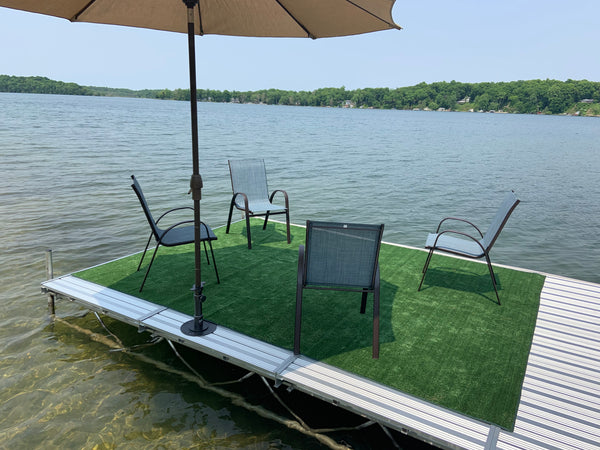
Planning Your New Dock
It’s that time of year, the sun is higher, days are gradually getting longer. Maybe, just maybe spring will pop its head out of the mountains of snow, the ice will break up and we’ll see open water. It is time for making maple syrup and planning spring building projects like new docks.
Docks are expensive. You want to get it right the first time. Before heading off to your Cottage or Home Show and enjoying all the beautiful dock options, have a few answers to questions about your shoreline, proposed dock usage, directional wind and sun, and portability. And don’t forget to plan for a Never-Blow-Over J-HOOK Umbrella Base for your shade options.
Aluminum Frames, wood frames, steel beams, wood decking, composite decking, plastic floats, barrels, aluminum platforms, poles, concrete weights. All excellent options when considering building a new dock, but bear in mind that lifestyle, shoreline variation, and budget will affect these decisions.
Below is a checklist to consider when planning your new dock.
- How do you want to use your dock?
- Mooring watercraft, purely functional
- Launching water toys
- Storing water toys and accessories
- Entertainment & Enjoyment, don’t forget you will need Never-Blow-Over Shade
- Garden space – access to water is never an issue
- Waterfront Topography
- Floor of your lake…
- Mud – hollow, vertical poles anchor well here.
- Sand – poles, anchors, platforms all would work well
- Floor of your lake…
- Rock – weighted anchors with chains work well here, or possibly aluminum platforms if rocks are level
- Prevailing Winds and Waves… Securing your structure
- Mooring chains and concrete weights – perfect placement is vital to do the job correctly.
- Poles hammered into the mud – an excellent option, but can be very hard work to remove in the fall
- Water Depth
- Shallow – would floats rest on the bottom? Not advisable.
- Very Deep – mooring chains need to be very long and well placed
- Extreme variation in depth – ministry managed levels – floats are ideal, aluminum poles would need adjusting frequently
- Ease of Access for pedestrians and pets
- Ramps – an easy option, especially if your lake levels change, but can be slippery and cumbersome
- Steps – comfortable, especially if you include a railing for safety, but do they need to be portable?
- Slippery surfaces are dangerous – consider an anti-slip treatment
- Winter Ice Damage – where does your ice go?
- Removable docks – there are many aluminum options available. Winter storage is a consideration.
- Float the docks to safe, open water and anchor with cememt blocks and ropes – you’ll need durable floats that withstand ice.
- Leave In place and hope for the best – you’ll need extremely durable floats and excellent mooring ropes or chains.
- Deck Flooring options
- Flow-through (plastic) with holes – a J-HOOK Fastening Bracket would need a “routered” hole to pass through to secure to the cross members or flooring joists.
- Composite decking – distance between boards is optional. Composite can become very hot in the sun.
- Wooden deck boards – Forgiving in spacing and accidental screw holes, individual boards can be replaced if damaged. Eastern White Cedar is best left untreated and allowed to weather to a silver patina.
- Dock Builders
- There are many excellent dock builders. Cottatge Shows and your happy neighbours are probably the best places to start.
- Find a dock builder local to you and your cottage so distances for visiting their showroom, asking questions, and potential build-on additions are easy.
- Ask about follow-up service. Things break, it’s a fact of life. Do they repair their docks? What is their warranty on their work?
- There are many excellent dock builders. Cottatge Shows and your happy neighbours are probably the best places to start.
- Get referrals from happy customers. Even better, find a happy customer with a similar waterfront shoreline to yours and go see their dock. Ask them about what they like and don’t like about their dock and its set-up.
- Self Build.
- This is an excellent and often more affordable option. There are many websites with dock plans and designs available, Your building center will also help with your plans.
- Research your plans, ask someone knowledgeable look at your design for potential pitfalls. Know your materials. Know your limitations in tools, manpower, strength and knowledge.
- Timing – do you want to build in black-fly season, the extreme heat of the summer, the cool spring and fall shoulder seasons?
Cottage Life Magazine June 2017 has a pretty good article on docks for shorelines, link: https://cottagelife.com/outdoors/what-type-of-dock-is-right-for-your-shoreline/
We often have J-HOOK customers asking about “nudging” their boards apart 3/16 inch to accommodate the stainless steel Fastening Bracket. So, if a J-HOOK is in your portable shade plan, bear in mind the spacing between your deck boards. Once your dock decision is made, take time to think about your shade solutions….. the Never-Blow-Over J-HOOK Umbrella Base for Decks and Docks.
Leave a comment
Comments will be approved before showing up.
Also in Lakehouse News


